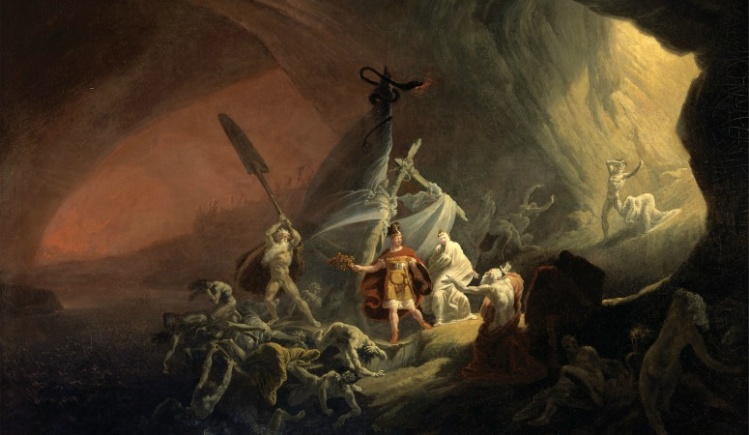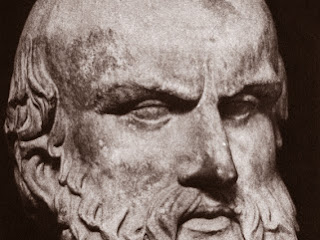 |
| Aeneid |
Virgil’s Aeneid is arguably the most influential and celebrated work of Latin literature. Written in the epic meter, dactylic hexameter, the Aeneid follows the journey of Aeneas, son of Venus, after the fall of
Troy. According to an ancient mythical tradition, Aeneas fled the burning city and landed in Italy, where he established a line of descendants who would become the Roman people.
Virgil (70–19 b.c.e.) draws on the works of numerous authors, such as Lucretius, Ennius, Apollonius of Rhodes, and, especially, Homer. Virgil consistently adopts Homeric style and diction (a good example of this is the first line of the poem: “I sing of arms and a man ...”).
He also re-creates entire scenes from the Iliad and the Odyssey. Books 1 to 6 of the Aeneid show such close parallels to the
Homeric epics that they are often called the “Virgilian Odyssey.”
Books 7 to 12, meanwhile, closely echo the Iliad. Virgil’s use of Homeric elements goes beyond mere imitation. Virgil often places Aeneas in situations identical to those of Odysseus or Achilles, allowing Aeneas’s response to those situations to differentiate him from (and sometimes surpass) his Homeric counterparts.
Virgil constructs his epic in relation to the Roman people and their cultural ideals. He defines Aeneas by the ethical quality of piety, a concept of particular importance for Rome at the time of the Aeneid’s composition. The Aeneid also contains several etiological stories of interest to the Roman people, most notably that of
Dido and the origin of the strife between the Romans and the Carthaginians.
The Dido episode is one of the most famous vignettes of the Aeneid. Dido, the queen of
Carthage—also known by her Phoenician name, Elyssa—aids Aeneas and his shipwrecked Trojans in Book 1. Through Venus’s intervention, Dido falls desperately in love with Aeneas and wants him and his men to remain in Carthage.
But a message from Jove reminds Aeneas that his fated land is in Italy. Immediately, he orders his men to depart. Dido is heartbroken over Aeneas’s leaving: She builds a pyre out of Aeneas’s gifts and commits suicide on it, prophesying the coming of
Hannibal before she dies. When Aeneas descends to the Underworld in Book 4, Dido’s shade refuses to speak with him.
Dido’s character shows a great deal of complexity. She appears first as an amalgam of Alcinous and Arete as she hospitably receives her Trojan guests but soon becomes a Medea figure, well acquainted with magic and arcane knowledge.
 |
| Aeneid and the sibyl |
Dido is a sympathetic character throughout the epic, though much of how Virgil describes her would have brought to the Roman reader’s mind the Egyptian queen Cleopatra (associated with Mark Antony and the civil war).
Interpretations of the Aeneid are numerous and far from unanimous. The Aeneid’s composition coincides with the end of the civil wars and the beginning of Augustus’s regime. Virgil ostensibly endorses the new princeps by referring to him as the man who will usher in another
golden age.
Yet several elements of the epic might suggest that Virgil did not wholeheartedly support
Augustus. Much of the debate centers on the war in Italy that occupies the second half of the epic, in which some scholars see a reference to the Battle of Perusia in 41 b.c.e., an event Augustus would have preferred to forget.
Scholars also point to the end of the Aeneid, where Aeneas kills Turnus as he pleads for his life, as unambiguously criticizing the new leadership. This anti-Augustan view of the Aeneid has, however, met with opposition.
Many scholars find more evidence of the Iliad than of Augustus’s campaign in the latter half of the Aeneid. Others suggest that in killing Turnus, Aeneas acted appropriately for his cultural circumstances.
The Aeneid has also been proposed to represent, not Virgil’s view of Augustus, but rather the condition of the Roman people. Virgil seems to offer conflicting evidence for his perspective on Augustan Rome and may intentionally leave the matter ambiguous so that the reader may decide for him- or herself.
The Aeneid was highly anticipated even before publication and has since enjoyed immense popularity. Quintilian regarded Virgil as nearly equal to Homer and credits him with having the more difficult task. Latin epic writers after Virgil looked to the Aeneid as their model. Statius even acknowledges that his epic, the The baid, cannot surpass that of Virgil.
The Aeneid became a standard school text of the ancient world and was a critical part of a good education. Virgil, however, considered the work unfinished. At the time of his death he famously called for the Aeneid to be burned rather than published. Augustus saved the Aeneid from the flames and ordered its publication.






















